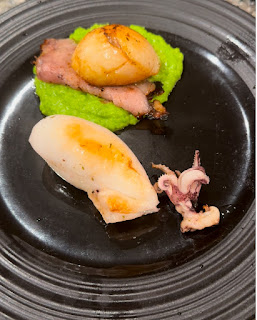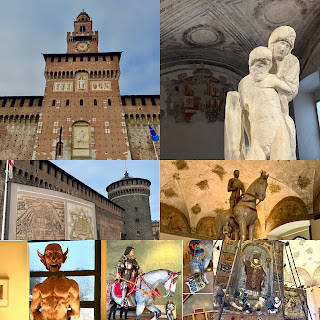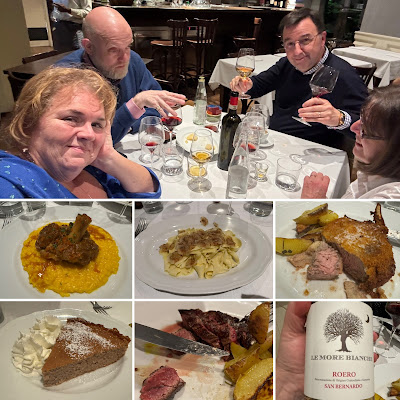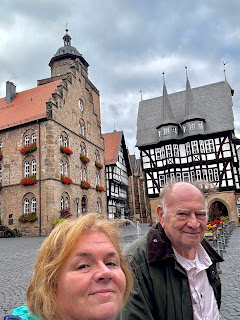Like so many Italian-American traditions, I suspect the Seven Fishes swam out of the giddy immigrant delight of cheap, easily available food. Families who, in their native land, could only afford animal proteins a few times a year could now have them every day. They celebrated and showed off their wealth. Food writers have traced the generous excesses of Italian-American cuisine back to this fact. (Given that most 19th century immigrants shared that reality, whatever their country of origin, I’ve always suspected it’s at the root of America’s gargantuan portion sizes in comparison to the rest of the world. But, admittedly, the Italian-American table does groan a little more heavily than most.
To be honest, our family didn’t really do the Seven Fishes. In the Missouri of the 1960s and ‘70s, a 12-hour drive from the nearest ocean, fresh fish was unknown at all but the priciest of restaurants and frozen food … while becoming more common … tended to offer only breaded fish fingers. I suppose someone could have come up with a muddy catfish, but seven fish dishes would have been ludicrous. My Sicilian grandfather honoured his piscine traditions with a bit of pickled herring out of a jar while the family sat down to something meaty; usually an enormous lasagne.
As an adult living on an island on which the most inland point is only 70 miles from the sea, however, I liked the sound of the Feste. More accurately, I liked the challenge. We never entertain at Christmas Eve. We’re either out, or it’s just the two of us. Would it be possible to prepare seven distinct fish dishes in one meal, in portion sizes that didn’t overwhelm?
I’ve played around with the challenge in years past, but 2024 is the year I got closest to acing this conundrum. My pasta serving should have been a bit smaller … we were too full to properly enjoy the course after … and I spent so much time getting portion sizes right that I fell down a bit on seasoning and small touches. Much of this tasted good, but a bit of attention to detail would have made it great.
Still, I have a template for future years. If you want to try the Feast of Seven Fishes for a small group, here’s a workable menu. I split the seven into four courses.
First Course: Amuse Bouche. These were three single bites, presented on special serving spoons. My bites were an anchovy wrapped around green olives, tuna (high-quality Sicilian, in a jar) stuffed into a peppadew pepper, and bit of avocado covered with crab meat. I could have added one more here and taken one off the next course to make life easier on myself, as the squid could have been served hot or cold.
Second Course: Warm Appetisers. I put two on a plate. A griddled stuffed squid was easy, coming already prepared from the deli at Italian Continental Stores. Left cold, this could have joined the amuse bouche. That sat next to a single scallop on pea puree and a bit of grilled ham. It’s normally done on black pudding but I’d already roasted a ham for other holiday meals and wanted to re-use ingredients.
Third Course: Pasta. I made three tactical errors with my Linguini Vongole, which I haven’t made in a very, very long time. First, lacking a linguini option on my pasta maker I opted for spaghetti rather than fettuccini. The thicker noodle would have worked better. Second, I dumped the liquid from the jar of clams when I should have used it to flavour the pasta. Third, I forgot how important really good olive oil is to this dish. Essentially, it’s really delicate and easy to create something extremely bland. I rescued it with a last-minute addition of the Sicilian olive oil our landlords from Ispica sent us home with earlier this year, but it could have been better out of the pan.
Fourth Course: From the Grill. Whole sea bass done “en papillote” with fennel, lemon and dill. Another tactical error … I didn’t open the packet from the fishmonger to see that my husband had bought a whole bass instead of fillets until an hour before serving. The papillote was a last-minute rescue because I didn’t have the time or confidence to fillet the fish myself. Had I realised I had a whole fish to work with I would have gotten supplies in to bake it in sea salt, but the only sea salt in the house was fancy stuff I’d purchased in Sicily and i wasn’t going to use that as a cooking medium.
Second Course: Warm Appetisers. I put two on a plate. A griddled stuffed squid was easy, coming already prepared from the deli at Italian Continental Stores. Left cold, this could have joined the amuse bouche. That sat next to a single scallop on pea puree and a bit of grilled ham. It’s normally done on black pudding but I’d already roasted a ham for other holiday meals and wanted to re-use ingredients.
Third Course: Pasta. I made three tactical errors with my Linguini Vongole, which I haven’t made in a very, very long time. First, lacking a linguini option on my pasta maker I opted for spaghetti rather than fettuccini. The thicker noodle would have worked better. Second, I dumped the liquid from the jar of clams when I should have used it to flavour the pasta. Third, I forgot how important really good olive oil is to this dish. Essentially, it’s really delicate and easy to create something extremely bland. I rescued it with a last-minute addition of the Sicilian olive oil our landlords from Ispica sent us home with earlier this year, but it could have been better out of the pan.
Fourth Course: From the Grill. Whole sea bass done “en papillote” with fennel, lemon and dill. Another tactical error … I didn’t open the packet from the fishmonger to see that my husband had bought a whole bass instead of fillets until an hour before serving. The papillote was a last-minute rescue because I didn’t have the time or confidence to fillet the fish myself. Had I realised I had a whole fish to work with I would have gotten supplies in to bake it in sea salt, but the only sea salt in the house was fancy stuff I’d purchased in Sicily and i wasn’t going to use that as a cooking medium.
Dessert: I made a simple lime posset, which is the kind of light, citric option perfect for ending this menu. We were so stuffed that we split one and only managed half of it, but it did wrap things up nicely.
And thus ended my culinary efforts on Christmas Eve. My lovely husband took over the kitchen the next day and switched the influences from Italian to Danish. (Crab salad, roast duck with red cabbage, Christmas pudding). Followed by the traditional Danish lunch of open-faced sandwiches, beer and snaps with friends on the 27th. Those feasts gave us enough leftovers to weather the rest of a quiet holiday season. Outside, it was grey, windy and wet. Indoors, we snuggled up with good books, good video, and good food. After a busy year, it was exactly the holiday season we needed.
And thus ended my culinary efforts on Christmas Eve. My lovely husband took over the kitchen the next day and switched the influences from Italian to Danish. (Crab salad, roast duck with red cabbage, Christmas pudding). Followed by the traditional Danish lunch of open-faced sandwiches, beer and snaps with friends on the 27th. Those feasts gave us enough leftovers to weather the rest of a quiet holiday season. Outside, it was grey, windy and wet. Indoors, we snuggled up with good books, good video, and good food. After a busy year, it was exactly the holiday season we needed.







































